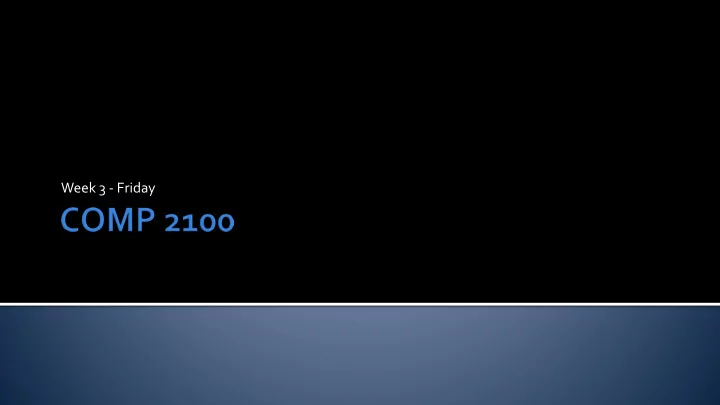

Week 3 - Friday
What did we talk about last time? Asymptotic notation practice Abstract data types Started stacks
O and Ω have a one-to-many relationship with functions 4 n 2 + 3 is O ( n 2 ) but it is also O ( n 3 ) and O ( n 4 log n ) 6 n log n is Ω ( n log n ) but it is also Ω ( n ) Θ is one-to-many as well, but it has a much tighter bound Sometimes it is hard to find Θ Upper bounding isn't too hard, but lower bounding is difficult for many real problems
1. If f ( n ) is O ( g ( n )) and g ( n ) is O ( h ( n )), then f ( n ) is O ( h ( n )) 2. If f ( n ) is O ( h ( n )) and g ( n ) is O ( h ( n )), then f ( n ) + g ( n ) is O ( h ( n )) 3. an k is O ( n k ) 4. n k is O ( n k + j ), for any positive j 5. If f ( n ) is cg ( n ), then f ( n ) is O ( g ( n )) 6. log a n is O (log b n ) for integers a and b > 1 7. log a n is O ( n k ) for integer a > 1 and real k > 0
public class ArrayStack { private int[] data; private int size; public ArrayStack() {} public void push(int value) {} public int pop() {} public int peek() {} //instead of top public int size() {} }
A queue is a simple data structure that has three basic operations (very similar to a stack) Enqueue Put an item at the back of the queue Dequeue Remove an item from the front of the queue Front Return the item at the front of the queue A queue is considered FIFO (First In First Out) or LILO (Last In Last Out)
Queues are useful whenever you want to keep track of the order of arrival A line in a fast food restaurant A job in a printer queue A buffer for managing data
A queue is a little bit harder to implement than a stack with an array The trouble is that you're enqueuing and dequeuing from different ends Removing something from the front seems to imply that you'll need to shift over all the contents of the array Enter the circular array!
A circular array is just a regular array However, we keep a start index as well as a size that lets us start the array at an arbitrary point Then, the contents of the array can go past the end of the array and wrap around The modulus operator ( % ) is a great way to implement the wrap around
Starting array Dequeue 1. 4. 3 21 9 7 18 3 21 Start Size = 3 Start Size = 4 Enqueue 9 Enqueue 14 2. 5. 7 18 3 21 9 14 3 21 9 Start Size = 5 Start Size = 4 Dequeue Dequeue 3. 6. 18 3 21 9 14 21 9 Start Size = 4 Start Size = 3
Advantages: Dequeue is Θ (1) Front is Θ (1) Disadvantages Enqueue is Θ ( n ) in the very worst case, but not in the amortized case
public class ArrayQueue { private int[] data = new int[10]; private int start = 0; private int size = 0; public void enqueue(int value) {} public int dequeue() {} public int front() {} public int size() {} }
Finish queues Linked lists
Keep reading section 1.3 Finish Assignment 1 Due tonight by midnight!
Recommend
More recommend